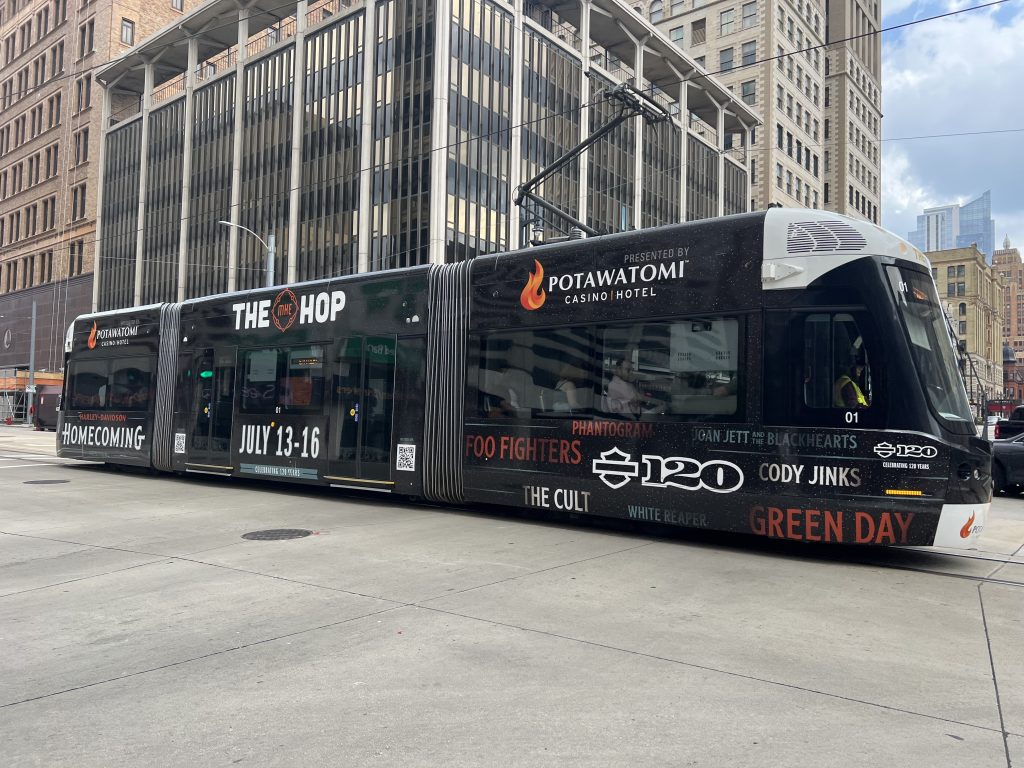Streetcar Ridership Has Climbed For 27 Straight Months Year-Over-Year
But is still below 2019 figures. Extension will open in October.
Ridership on The Hop, Milwaukee’s streetcar system, is continuing to rebound as the COVID-19 pandemic abates.
For 27 straight months, the system has recorded a year-over-year increase in average ridership. And on Saturday, July 15, the five-year-old system set a post-March 2020 record with 6,883 trips, the fourth-highest day in its history.
Bastille Days, which occurs alongside the system’s route in Cathedral Square Park, has consistently caused mid-July traffic surges. This year’s festival was aided by the Harley-Davidson Homecoming celebration, which included a sponsored streetcar.
“The strong ridership numbers from last weekend are further evidence that The Hop is delivering on its promise to contribute to a more vibrant and accessible downtown community,” said Mayor Cavalier Johnson in a statement announcing the ridership figures. “Part of what makes weekends like these so important is that a lot of new riders are introduced to the benefits of convenient and accessible transit, and that will go a long way towards not only turning new riders into repeat riders but also bolstering our broader efforts to support transit and build safer streets.”
Automatic passenger counters embedded in the vehicles’ doors record ridership data. The resulting data is posted on The Hop’s website.
The 2.1-mile system is currently free to ride. The 2023 city budget calls for $4.9 million to be spent on operating the streetcar system. That expense is to be offset by $3.5 million in direct revenue, with the remainder coming from the city’s parking revenue. Direct revenue sources include Potawatomi Hotel & Casino ($833,333), other sponsors ($390,000), a federal pandemic-related transit grant ($2.1 million) and a federal transit support grant ($214,000).
The city estimated 1,800 daily rides as part of the system’s 2011 environmental impact statement. The system was eclipsing that figure until the pandemic struck, and now is reporting ridership figures at approximately 70% of its pre-pandemic levels. That percentage is in line with other transit systems, according to data aggregated by the American Public Transport Association.
June 2023, the last month for which full data is available, was reported to have an average of 1,676 daily rides. That total eclipses 1,030 monthly rides in June 2022, but is below the 2,379 daily rides seen in June 2019.
A lakefront extension of the system, approved alongside the rest of the system in 2015, is scheduled to begin service in October according to remarks from Department of Public Works representatives to the Finance & Personnel Committee earlier this week. The extension, which has set mostly completed since 2018, was repeatedly delayed due to delays with The Couture, the 44-story tower through which the extension will turn around. Testing for the segment began in recent weeks.
The system’s Hop Summer Nights promotion will return in August. From 4 p.m. to 6 p.m. on Aug. 13 and 20 riders will be able to enjoy live jazz music and free popsicles aboard a vehicle. To find the specific vehicle offering the service, riders are advised to use the real-time tracking application and The Hop’s social media accounts.
What day has the highest ridership in The Hop’s history? Saturday, July 13, 2019. The system recorded 8,969 rides that day, aided by Bastille Days. It eclipsed the prior high of 7,798 set Nov. 3, 2018, the system’s first full day of operation. The Friday of Bastille Days 2019 is the third day that eclipses the 2023 record.
If you think stories like this are important, become a member of Urban Milwaukee and help support real, independent journalism. Plus you get some cool added benefits.
More about the Milwaukee Streetcar
For more project details, including the project timeline, financing, route and possible extensions, see our extensive past coverage.
- FTA Tells Milwaukee to Crack Down on Fare Evasion — Even Where Fares Don’t Exist - Graham Kilmer - Dec 12th, 2025
- Alderman, State Allies Seek Federal Help to Kill the Streetcar - Jeramey Jannene - Oct 28th, 2025
- Streetcar Service Suspended Following Truck Crash - Jeramey Jannene - Oct 21st, 2025
- One Alderman’s Quest To Defund The Streetcar - Jeramey Jannene - Oct 18th, 2025
- Another Streetcar Collision - Jeramey Jannene - Jun 27th, 2025
- Streetcar Hit By Apparent Red Light Runner - Jeramey Jannene - Jun 16th, 2025
- Streetcar Will Run On Consolidated Route During Summerfest - Jeramey Jannene - Jun 11th, 2025
- City Hall: Milwaukee Must Replace Failing Streetcar Switches - Jeramey Jannene - Feb 24th, 2025
- Streetcar Confronts Limited Funding, Operations Challenges - Evan Casey - Jan 22nd, 2025
- Council Kills Streetcar’s ‘Festivals Line’ - Jeramey Jannene - Jul 31st, 2024
Read more about Milwaukee Streetcar here
Transportation
-
Congestion Pricing Cuts Air Pollution in New York City
 Dec 14th, 2025 by Jeff Wood
Dec 14th, 2025 by Jeff Wood
-
FTA Tells Milwaukee to Crack Down on Fare Evasion — Even Where Fares Don’t Exist
 Dec 12th, 2025 by Graham Kilmer
Dec 12th, 2025 by Graham Kilmer
-
Will GOGO’s Bus Service Ever Get Going?
 Dec 9th, 2025 by Jeramey Jannene
Dec 9th, 2025 by Jeramey Jannene




















Good to hear. Free obviously helps, but that could also be useful training for maintaining future ridership provided costs don’t go up too much. It’s great for weekends, but I’m sure it’s also a boon for someone looking to move back to the city, or young newbies coming in.
Based on an average of 1676 daily riders (June 2023) and an annual operating budget of $4,900,000 that comes to almost exactly $8.00 per ride. No doubt there is an annual capital budget too, so $8.00 probably significantly understates the true cost per ride.
What would the ridership be if everyone had to pay for a ticket? My wife, daughter and I rode it during Bastille days to get from where we parked to the festival. If I had to pay $48 for 3 people to go there and back, I would have parked across the street from the festival in structured parking and spent the difference on beignets.
What is worse is that it doesn’t do anything a bus cannot do for a lower cost. If Milwaukee leadership wanted to put in a 21st century trolley, they could have put in electric buses with wireless charging.